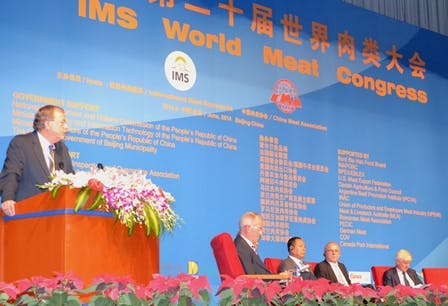China Leadership Team Tackles Issues, Examines Market

USMEF Vice Chair and China Leadership Team member Roel Andriessen (left, at podium) participates on a food security and safety issues panel at the World Meat Congress
USMEF’s China Leadership Team (CLT) just completed a week of activities in Beijing aimed at addressing trade issues and market access challenges, while also interacting with key beef and pork industry players to assess the commercial potential of the region. Industry representatives serving on the CLT include USMEF Vice Chair Roel Andriessen of Tyson Foods, USMEF immediate past chairman Steve Isaf of Interra International, Norman Bessac of Cargill Meat Solutions, David Peterson of Seaboard Foods, Jack Shao of Hormel Foods and Roger Goulding of JBS USA.
In their fourth visit to China’s capital city in as many years, team members met with officials from China’s Ministry of Agriculture and Ministry of Commerce, as well as representatives of China’s meat processing and meat trade industry associations. In a meeting with U.S. officials, including U.S. Ambassador to China Max Baucus, exporters stressed the importance of reestablishing U.S. beef access as soon as possible. They noted that China and the United States made a high-level agreement to have U.S. beef back in the market this year, perhaps as early as July. Between CLT engagements, team members attended the 20th World Meat Congress conducted by the International Meat Secretariat (IMS) and hosted this year by the China Meat Association. The group also attended the China International Meat Industry Exhibition (CIMIE), China’s largest meat and meat processing equipment trade show, and had one-on-one meetings with senior executives from many of China’s largest meat processing companies.
At the meetings with the Ministries of Agriculture and Commerce, beef access was a main topic of discussion.
“Officials from both ministries indicate a willingness to have U.S. beef back in the market,” said Philip Seng, USMEF President and CEO. “Domestic beef supplies are tight in the face of rising demand, and China has a preference for having a diverse range of suppliers.”
CLT members shared information on the U.S. beef production and processing system with livestock and veterinary officials from the Ministry of Agriculture, including several that joined a technical team that departed for the United States June 16 to observe the U.S. system for mitigating BSE risk. The technical team also includes officials from China’s General Administration of Quality Supervision, Inspection and Quarantine (AQSIQ). Capability of the U.S. industry to trace cattle movements and the processing industry’s protocol and practices regarding SRM removal are likely to be two areas of focus during the team’s visit to the United States.
The CLT also addressed current pork trade challenges, including the sudden de-listing of plants, and new (effective July 1) USDA requirements for the export of ractopamine-free pork to China. Team members engaged with representatives of China’s Entry-Exit Inspection and Quarantine Association (CIQA) on how to work together on an industry-to-industry level to smooth trade problems. Under a 2006 memorandum of cooperation between AQSIQ (CIQA’s government parental agency) and USDA, both agreed to establish an early warning system that establish protocols for exchanging information on food safety-related trade problems. CLT members explained that under USDA’s new ractopamine-free program, plants that are currently ineligible for export to China should be reinstated as long as they meet the new export requirements. USMEF and CIQA also pledged to undertake regular exchanges on mutual trade problems under the terms of a memorandum of understanding signed in September 2013. Another issue targeted for discussion at a future meeting is China’s current restrictions on U.S. processed pork products.
The larger issue of how China will produce enough meat to feed its population is of key interest to CLT members, as it involves questions of how China will embrace technology, address environmental challenges and evaluate imports as a food security solution. In opening remarks at the World Meat Congress, CIQA President and former AQSIQ vice minister Ge Zhirong acknowledged the growing role of imports in China’s dynamic meat market. High domestic swine inventories and relatively sluggish consumption have flattened the growth curve of China’s pork imports this year, but extremely tight beef and lamb supplies have caused an explosive growth in trade of these products – even to the extent that imports are being further fabricated at domestic slaughter and processing plants.
In the final leadership colloquium of the World Meat Congress, Andriessen joined representatives from JBS, Shuanghui, Heilongjiang Grand Farm Industrial Co., Ltd., Danish Crown, and Henan Zhongpin Food Share Co., Ltd. in a spirited exchange on food security, safety and sustainability. Andriessen explained Tyson Foods’ food safety culture and the important roles trade and science-based technology play in feeding a hungry world. Jeremiah O'Callaghan, investor relations director for JBS, also addressed the importance of international trade in delivering affordable products to consumers.

USMEF meets with representatives of Japan’s Agriculture and Livestock Industries Corporation (ALIC) in Beijing
On the sidelines of CIMIE, CLT members met one-on-one in business meetings with some of China’s major meat processors, including representatives of industry giants New Hope Group and Linyi Xincheng Jinluo. While the event consists mostly of domestic Chinese industry exhibits, a U.S. chilled pork sampling was featured at CIMIE for the first time.
While in Beijing, USMEF also held its annual meeting with representatives from Japan’s Agriculture and Livestock Industries Corporation (ALIC). This meeting offers an excellent opportunity to exchange information on market conditions and trends and to discuss issues affecting meat consumption and demand.
